One Metre Plus (1M+): A Multifunctional Open-Source Sensor for Bicycles Based on Raspberry Pi
Abstract
1. Introduction
2. Review of Instrumented Bicycles for Measuring Lateral Distance Passing
2.1. Why Develop an Open-Source Product?
2.2. Devices for Measuring Lateral Passing Distance: A Brief Overview
3. Material and Methods
3.1. Preliminary Assessment
3.2. Electronic Devices
3.3. Connection Diagram
- An HW 775 (Makerfocus, China) card which manages charging and discharging of the device and also protects the system from eventual electrical peaks.
- Four lithium Pkcell batteries (Shenzhen, Hong Kong, China) of 2200 mAh each for a total of 8800 mAh (approximately seven hours of continuous recording).
- A sealed Twidec switch (Suzhou, China) to allow the current to be conducted to the device as a whole.
- A sealed micro Cerrxian USB port (China) to recharge the batteries and to which it is also possible to connect Power Banks to increase autonomy during a data collection session.
- The tactile screen as a collection device for user commands.
- The DS3231 RTC clock which memorizes the time and transmits it to the Raspberry pi, the latter being directly welded to the superior pins of the nano computer.
- Finally, the hub zero USB is the connection bridge between the devices from 3 USB adaptors toward ttl, one last USB micro port is available to download the collected files during the bicycle trips.
3.4. Software
- For the distance sensor, a CSV file including the time (in milliseconds) of the event and the distance in centimetres.
- For the GPS, a CSV file with the time (in milliseconds) and the coordinates of the geographical position (longitude and latitude).
- For the fish-eye camera, a file of h.264 format.
3.5. Product Design and 3D Modeling
3.6. User Interface
3.7. Data Collection
4. Results
4.1. Spatial Observations
4.2. Camera Resolution
4.3. Distance Measures by Vehicle
4.4. Technical Data—Product Characteristics
5. Discussion
5.1. Comparison with Previous Devices
5.2. Limits of the Sensor and Potential Improvements
- A microphone to record the video with the environmental sound.
- A Bluetooth speedometer (with a sensor attached to the wheel) to accurately measure speed and distance.
- Gyroscopes and accelerometers to measure cyclist stability during the overtaking manoeuvre.
- A push-button that allows the cyclist to identify dangerous manoeuvres or other conflicts. This could be useful to evaluate differences between perceived and real risks.
5.3. Contribution to Research
6. Conclusions
Supplementary Materials
Author Contributions
Funding
Institutional Review Board Statement
Informed Consent Statement
Acknowledgments
Conflicts of Interest
References
- Gadsby, A.; Watkins, K. Instrumented Bikes and Their Use in Studies on Transportation Behaviour, Safety, and Maintenance. Transp. Rev. 2020, 40, 774–795. [Google Scholar] [CrossRef]
- Rubie, E.; Haworth, N.; Twisk, D.; Yamamoto, N. Influences on Lateral Passing Distance When Motor Vehicles Overtake Bicycles: A Systematic Literature Review. Transp. Rev. 2020, 40, 754–773. [Google Scholar] [CrossRef]
- Langford, B.C.; Chen, J.; Cherry, C.R. Risky Riding: Naturalistic Methods Comparing Safety Behavior from Conventional Bicycle Riders and Electric Bike Riders. Accid. Anal. Prev. 2015, 82, 220–226. [Google Scholar] [CrossRef] [PubMed]
- Huertas-Leyva, P.; Dozza, M.; Baldanzini, N. Investigating Cycling Kinematics and Braking Maneuvers in the Real World: E-Bikes Make Cyclists Move Faster, Brake Harder, and Experience New Conflicts. Transp. Res. Part F Traffic Psychol. Behav. 2018, 54, 211–222. [Google Scholar] [CrossRef]
- Lopez, A.J.; Astegiano, P.; Gautama, S.; Ochoa, D.; Tampère, C.; Beckx, C. Unveiling E-Bike Potential for Commuting Trips from GPS Traces. ISPRS Int. J. Geo-Inf. 2017, 6, 190. [Google Scholar] [CrossRef]
- Vlakveld, W.P.; Twisk, D.; Christoph, M.; Boele, M.; Sikkema, R.; Remy, R.; Schwab, A.L. Speed Choice and Mental Workload of Elderly Cyclists on E-Bikes in Simple and Complex Traffic Situations: A Field Experiment. Accid. Anal. Prev. 2015, 74, 97–106. [Google Scholar] [CrossRef] [PubMed]
- Twisk, D.; Boele, M.; Vlakveld, W.; Christoph, M.; Sikkema, R.; Remij, R.; Schwab, A. Preliminary Results from a Field Experiment on E-Bike Safety: Speed Choice and Mental Workload for Middle-Aged and Elderly Cyclists. In Proceedings of the International Cycling Safety Conference 2013, ICSC2013, Helmond, The Netherlands, 20–21 November 2013; Acquire Publishing BV: Schreevenweg, The Netherlands, 2013; pp. 1–15. [Google Scholar]
- Petzoldt, T.; Schleinitz, K.; Heilmann, S.; Gehlert, T. Traffic Conflicts and Their Contextual Factors When Riding Conventional vs. Electric Bicycles. Transp. Res. Part F Traffic Psychol. Behav. 2017, 46, 477–490. [Google Scholar] [CrossRef]
- Kovácsová, N.; de Winter, J.C.F.; Schwab, A.L.; Christoph, M.; Twisk, D.A.M.; Hagenzieker, M.P. Riding Performance on a Conventional Bicycle and a Pedelec in Low Speed Exercises: Objective and Subjective Evaluation of Middle-Aged and Older Persons. Transp. Res. Part F Traffic Psychol. Behav. 2016, 42, 28–43. [Google Scholar] [CrossRef]
- Apparicio, P.; Carrier, M.; Gelb, J.; Séguin, A.-M.; Kingham, S. Cyclists’ Exposure to Air Pollution and Road Traffic Noise in Central City Neighbourhoods of Montreal. J. Transp. Geogr. 2016, 57, 63–69. [Google Scholar] [CrossRef]
- Apparicio, P.; Gelb, J.; Carrier, M.; Mathieu, M.-È.; Kingham, S. Exposure to Noise and Air Pollution by Mode of Transportation during Rush Hours in Montreal. J. Transp. Geogr. 2018, 70, 182–192. [Google Scholar] [CrossRef]
- Liu, Y.; Lan, B.; Shirai, J.; Austin, E.; Yang, C.; Seto, E. Exposures to Air Pollution and Noise from Multi-Modal Commuting in a Chinese City. Int. J. Environ. Res. Public Health 2019, 16, 2539. [Google Scholar] [CrossRef] [PubMed]
- Boogaard, H.; Borgman, F.; Kamminga, J.; Hoek, G. Exposure to Ultrafine and Fine Particles and Noise during Cycling and Driving in 11 Dutch Cities. Atmos. Environ. 2009, 43, 4234–4242. [Google Scholar] [CrossRef]
- Okokon, E.O.; Yli-Tuomi, T.; Turunen, A.W.; Taimisto, P.; Pennanen, A.; Vouitsis, I.; Samaras, Z.; Voogt, M.; Keuken, M.; Lanki, T. Particulates and Noise Exposure during Bicycle, Bus and Car Commuting: A Study in Three European Cities. Environ. Res. 2017, 154, 181–189. [Google Scholar] [CrossRef]
- Dekoninck, L.; Botteldooren, D.; Panis, L.I.; Hankey, S.; Jain, G.; Karthik, S.; Marshall, J. Applicability of a Noise-Based Model to Estimate in-Traffic Exposure to Black Carbon and Particle Number Concentrations in Different Cultures. Environ. Int. 2015, 74, 89–98. [Google Scholar] [CrossRef]
- Minet, L.; Stokes, J.; Scott, J.; Xu, J.; Weichenthal, S.; Hatzopoulou, M. Should Traffic-Related Air Pollution and Noise Be Considered When Designing Urban Bicycle Networks? Transp. Res. Part D Transp. Environ. 2018, 65, 736–749. [Google Scholar] [CrossRef]
- Apparicio, P.; Gelb, J. Cyclists′ Exposure to Road Traffic Noise: A Comparison of Three North American and European Cities. Acoustics 2020, 2, 73–86. [Google Scholar] [CrossRef]
- Werneke, J.; Dozza, M.; Karlsson, M. Safety–Critical Events in Everyday Cycling—Interviews with Bicyclists and Video Annotation of Safety–Critical Events in a Naturalistic Cycling Study. Transp. Res. Part F Traffic Psychol. Behav. 2015, 35, 199–212. [Google Scholar] [CrossRef]
- Angel-Domenech, A.; Garcia, A.; Agustin-Gomez, F.; Llorca, C. Traffic Conflict Analysis by an Instrumented Bicycle on Cycle Tracks of Valencia. In Proceedings of the 3rd International Cycling Safety Conference, Gothenburg, Sweden, 18–19 November 2014; pp. 1–19. [Google Scholar]
- Jahangiri, A.; Elhenawy, M.; Rakha, H.; Dingus, T.A. Investigating Cyclist Violations at Signal-Controlled Intersections Using Naturalistic Cycling Data. In Proceedings of the 2016 IEEE 19th International Conference on Intelligent Transportation Systems (ITSC), Rio de Janeiro, Brazil, 1–4 November 2016; pp. 2619–2624. [Google Scholar]
- Schleinitz, K.; Petzoldt, T.; Franke-Bartholdt, L.; Krems, J.; Gehlert, T. Conflict Partners and Infrastructure Use in Safety Critical Events in Cycling—Results from a Naturalistic Cycling Study. Transp. Res. Part F Traffic Psychol. Behav. 2015, 31, 99–111. [Google Scholar] [CrossRef]
- Reynolds, C.C.; Harris, M.A.; Teschke, K.; Cripton, P.A.; Winters, M. The Impact of Transportation Infrastructure on Bicycling Injuries and Crashes: A Review of the Literature. Environ. Health 2009, 8, 47. [Google Scholar] [CrossRef]
- Gustafsson, L.; Archer, J. A Naturalistic Study of Commuter Cyclists in the Greater Stockholm Area. Accid. Anal. Prev. 2013, 58, 286–298. [Google Scholar] [CrossRef]
- Li, G.; Song, Z.; Fu, Q. A New Method of Image Detection for Small Datasets under the Framework of YOLO Network. In Proceedings of the 2018 IEEE 3rd Advanced Information Technology, Electronic and Automation Control Conference (IAEAC), Chongqing, China, 12–14 October 2018; pp. 1031–1035. [Google Scholar]
- Redmon, J.; Divvala, S.; Girshick, R.; Farhadi, A. You Only Look Once: Unified, Real-Time Object Detection. In Proceedings of the IEEE Conference on Computer Vision and Pattern Recognition, San Francisco, CA, USA, 18–20 June 2016; pp. 779–788. [Google Scholar]
- Jeon, W.; Rajamani, R. Rear Vehicle Tracking on a Bicycle Using Active Sensor Orientation Control. IEEE Trans. Intell. Transp. Syst. 2018, 19, 2638–2649. [Google Scholar] [CrossRef]
- Beck, B.; Chong, D.; Olivier, J.; Perkins, M.; Tsay, A.; Rushford, A.; Li, L.; Cameron, P.; Fry, R.; Johnson, M. How Much Space Do Drivers Provide When Passing Cyclists? Understanding the Impact of Motor Vehicle and Infrastructure Characteristics on Passing Distance. Accid. Anal. Prev. 2019, 128, 253–260. [Google Scholar] [CrossRef]
- Chuang, K.-H.; Hsu, C.-C.; Lai, C.-H.; Doong, J.-L.; Jeng, M.-C. The Use of a Quasi-Naturalistic Riding Method to Investigate Bicyclists’ Behaviors When Motorists Pass. Accid. Anal. Prev. 2013, 56, 32–41. [Google Scholar] [CrossRef] [PubMed]
- Shackel, S.C.; Parkin, J. Influence of Road Markings, Lane Widths and Driver Behaviour on Proximity and Speed of Vehicles Overtaking Cyclists. Accid. Anal. Prev. 2014, 73, 100–108. [Google Scholar] [CrossRef]
- Walker, I.; Garrard, I.; Jowitt, F. The Influence of a Bicycle Commuter’s Appearance on Drivers’ Overtaking Proximities: An on-Road Test of Bicyclist Stereotypes, High-Visibility Clothing and Safety Aids in the United Kingdom. Accid. Anal. Prev. 2014, 64, 69–77. [Google Scholar] [CrossRef] [PubMed]
- Dozza, M.; Schindler, R.; Bianchi-Piccinini, G.; Karlsson, J. How Do Drivers Overtake Cyclists? Accid. Anal. Prev. 2016, 88, 29–36. [Google Scholar] [CrossRef] [PubMed]
- Parkin, J.; Meyers, C. The Effect of Cycle Lanes on the Proximity between Motor Traffic and Cycle Traffic. Accid. Anal. Prev. 2010, 42, 159–165. [Google Scholar] [CrossRef] [PubMed]
- Llorca, C.; Angel-Domenech, A.; Agustin-Gomez, F.; Garcia, A. Motor Vehicles Overtaking Cyclists on Two-Lane Rural Roads: Analysis on Speed and Lateral Clearance. Saf. Sci. 2017, 92, 302–310. [Google Scholar] [CrossRef]
- Mehta, K.; Mehran, B.; Hellinga, B. Evaluation of the Passing Behavior of Motorized Vehicles When Overtaking Bicycles on Urban Arterial Roadways. Transp. Res. Rec. 2015, 2520, 8–17. [Google Scholar] [CrossRef]
- Bonvoisin, J. Limits of Ecodesign: The Case for Open Source Product Development. Int. J. Sustain. Eng. 2017, 10, 198–206. [Google Scholar] [CrossRef]
- Bonvoisin, J.; Boujut, J.-F. Open Design Platforms for Open Source Product Development: Current State and Requirements. In Proceedings of the 20th International Conference on Engineering Design (ICED 15), DS 80-8, Milan, Italy, 27–30 July 2015; Volume 8, pp. 11–20. [Google Scholar]
- Balka, K.; Raasch, C.; Herstatt, C. How Open Is Open Source?—Software and Beyond. Creat. Innov. Manag. 2010, 19, 248–256. [Google Scholar] [CrossRef]
- Mobasheri, A. Open Source Geospatial Science for Urban Studies: The Value of Open Geospatial Data; Springer Nature: Cham, Switzerland, 2020; ISBN 3-030-58232-9. [Google Scholar]
- Mobasheri, A.; Mitasova, H.; Neteler, M.; Singleton, A.; Ledoux, H.; Brovelli, M.A. Highlighting Recent Trends in Open Source Geospatial Science and Software. Trans. GIS 2020, 24, 1141–1146. [Google Scholar] [CrossRef]
- Stewart, K.; McHale, A. Cycle Lanes: Their Effect on Driver Passing Distances in Urban Areas. Transport 2014, 29, 307–316. [Google Scholar] [CrossRef][Green Version]
- Bernal, D.; Vanegas, A.; Pachon Arttesano, J.C. CanAirIO. Available online: https://canair.io/docs/ (accessed on 13 May 2021).
- Gandhi, A. Object Detection Using Deep Learning on a Raspberry Pi. Available online: https://www.hackster.io/arun-gandhi/object-detection-using-deep-learning-on-a-raspberry-pi-32f94c (accessed on 13 May 2021).
- The Raspberry Pi Foundation Raspberry Pi Images. Available online: https://www.raspberrypi.org/software/operating-systems/ (accessed on 31 May 2021).
- Python. Available online: https://www.python.org/ (accessed on 31 May 2021).
- LAEQ. Available online: https://github.com/LAEQ/OneMetrePlus (accessed on 31 May 2021).
- Onshape|Product Development Platform. Available online: https://www.onshape.com/en/ (accessed on 19 May 2021).
- R Core Team. R: A Language and Environment for Statistical Computing; R Foundation for Statistical Computing: Vienna, Austria, 2021. [Google Scholar]
- Apparicio, P.; Maignan, D.; Gelb, J. VIFECO: An Open-Source Software for Counting Features on a Video. J. Open Res. Softw. 2021, 9, 7. [Google Scholar] [CrossRef]
- Li, X.; Yuan, F.; Lindqvist, J. Feasibility of Software-Based Duty Cycling of GPS for Trajectory-Based Services. In Proceedings of the 2016 13th IEEE Annual Consumer Communications Networking Conference (CCNC), Las Vegas, NV, USA, 9–12 January 2016; pp. 18–26. [Google Scholar]
- Spannbauer, A. Vidstab. Available online: https://pypi.org/project/vidstab/ (accessed on 15 June 2021).
- OpenCV. Available online: https://opencv.org/ (accessed on 15 June 2021).
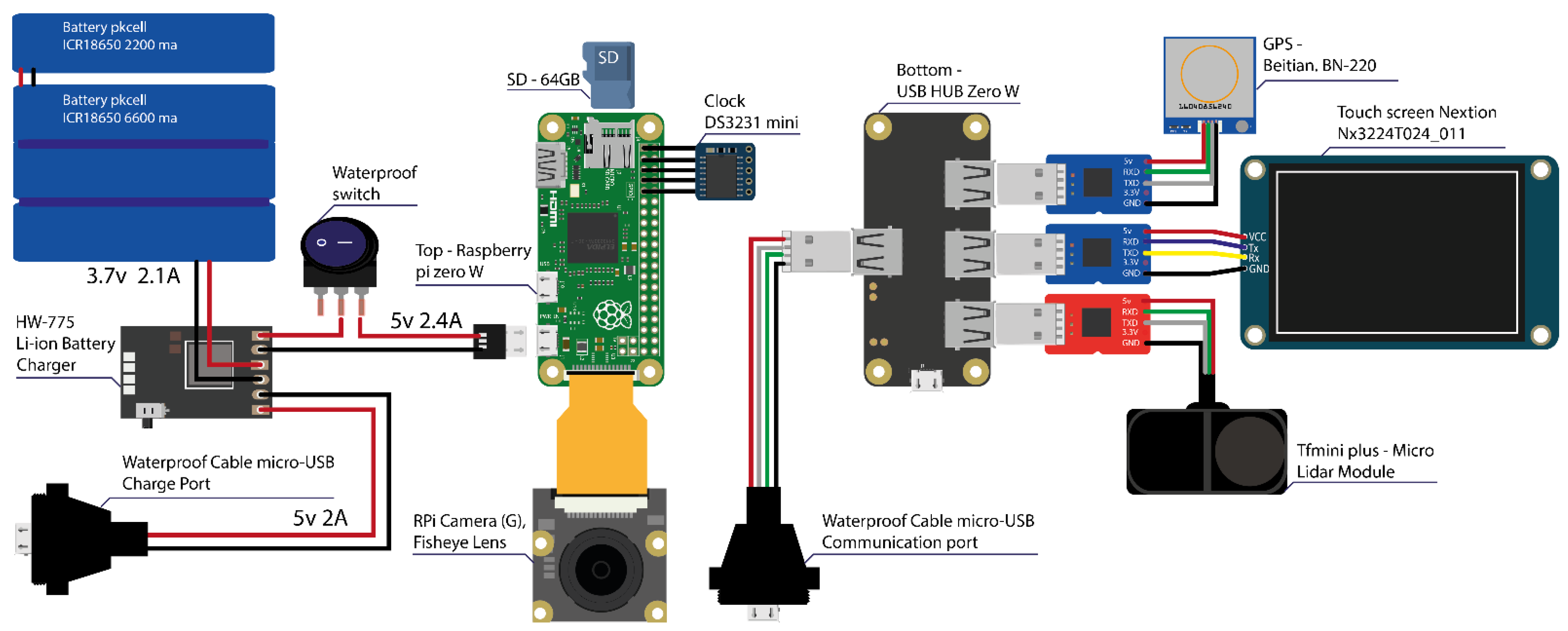

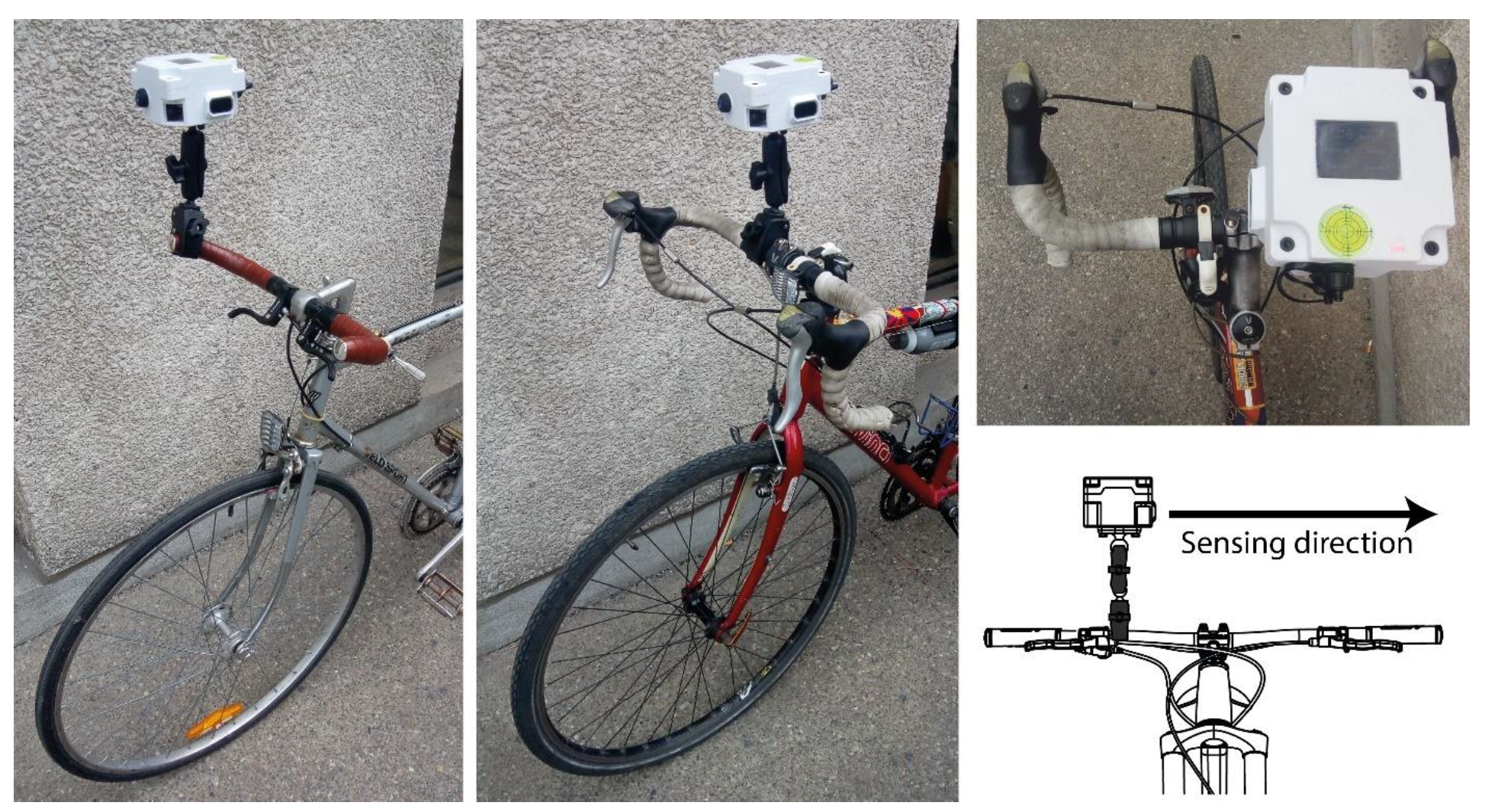
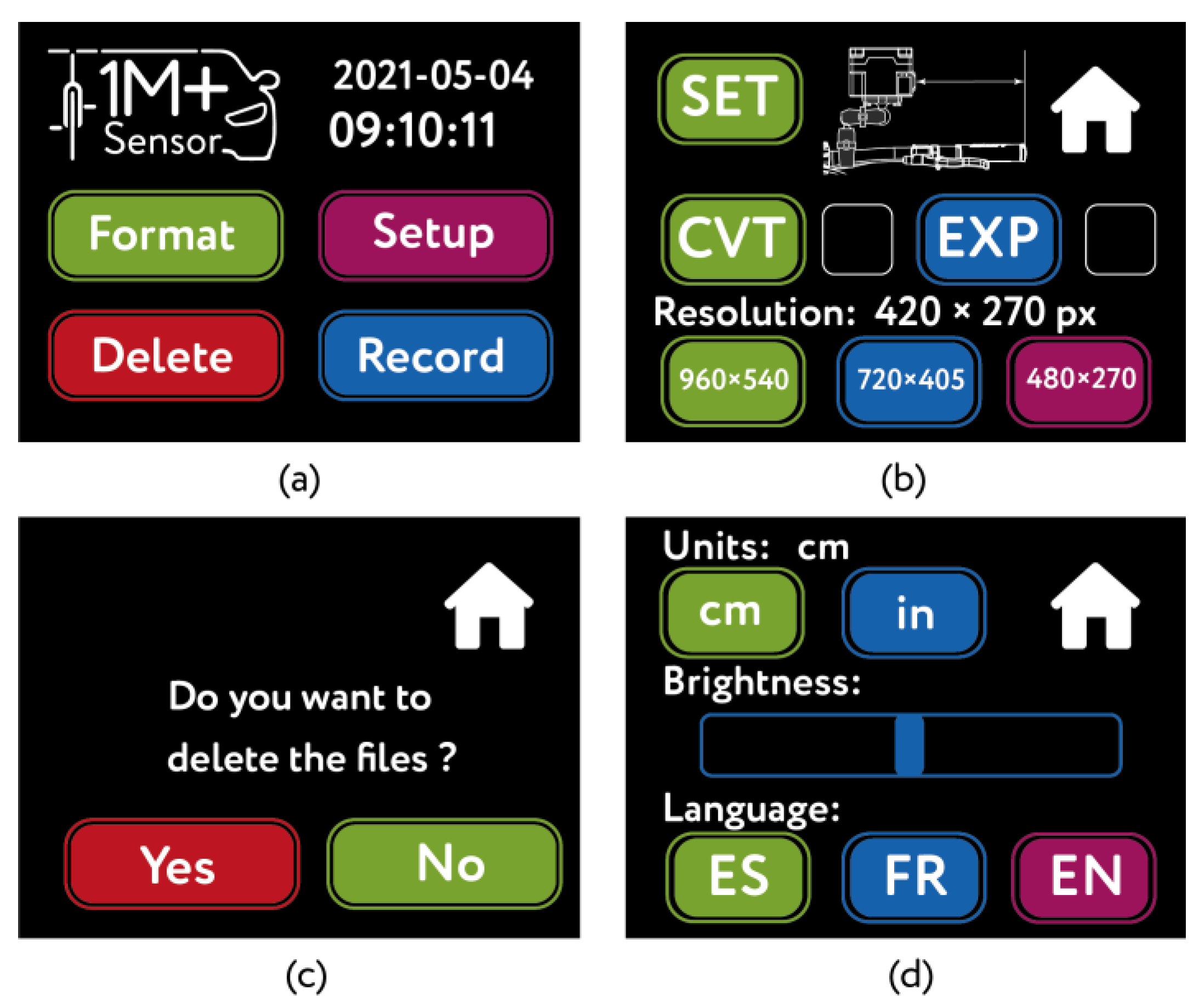


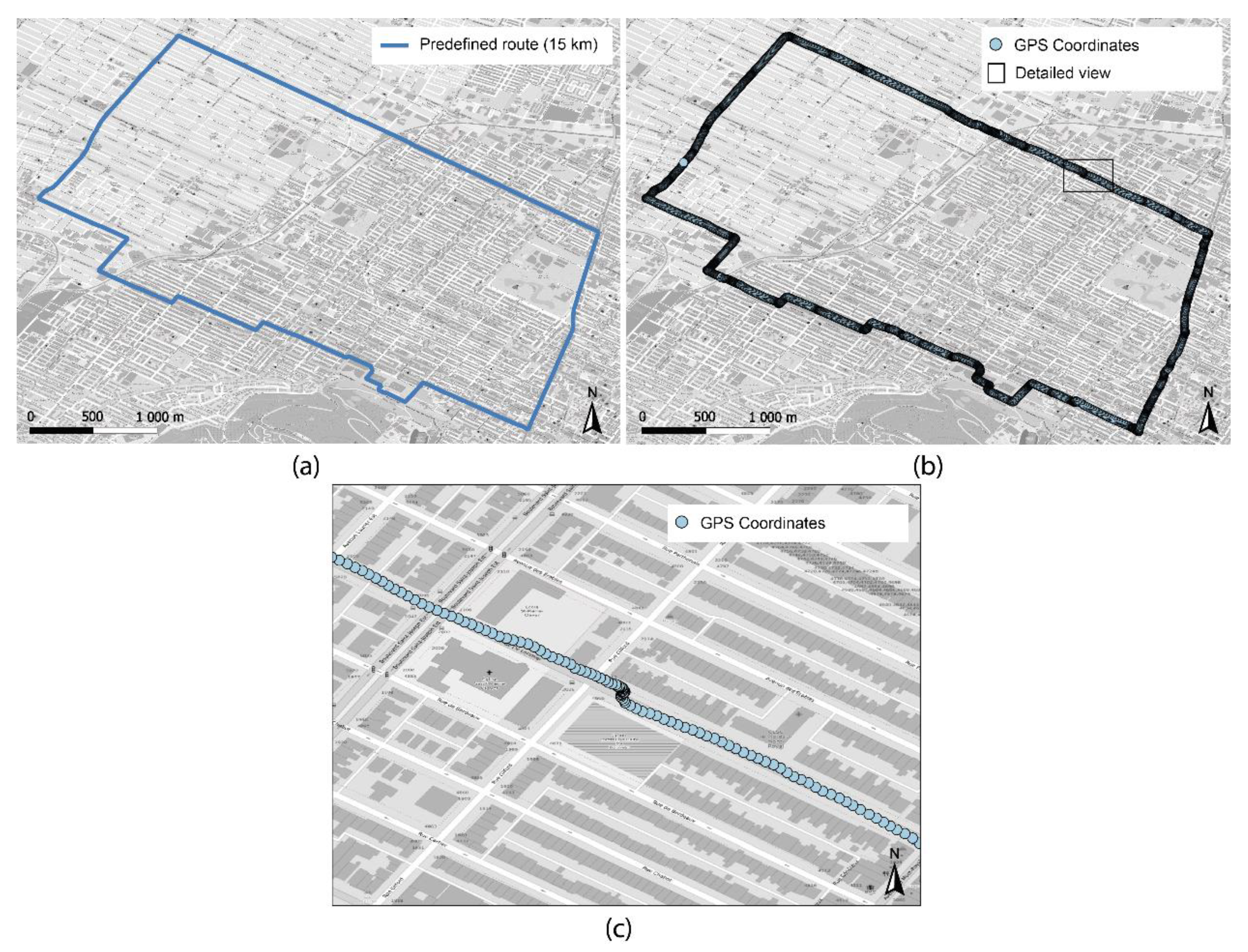

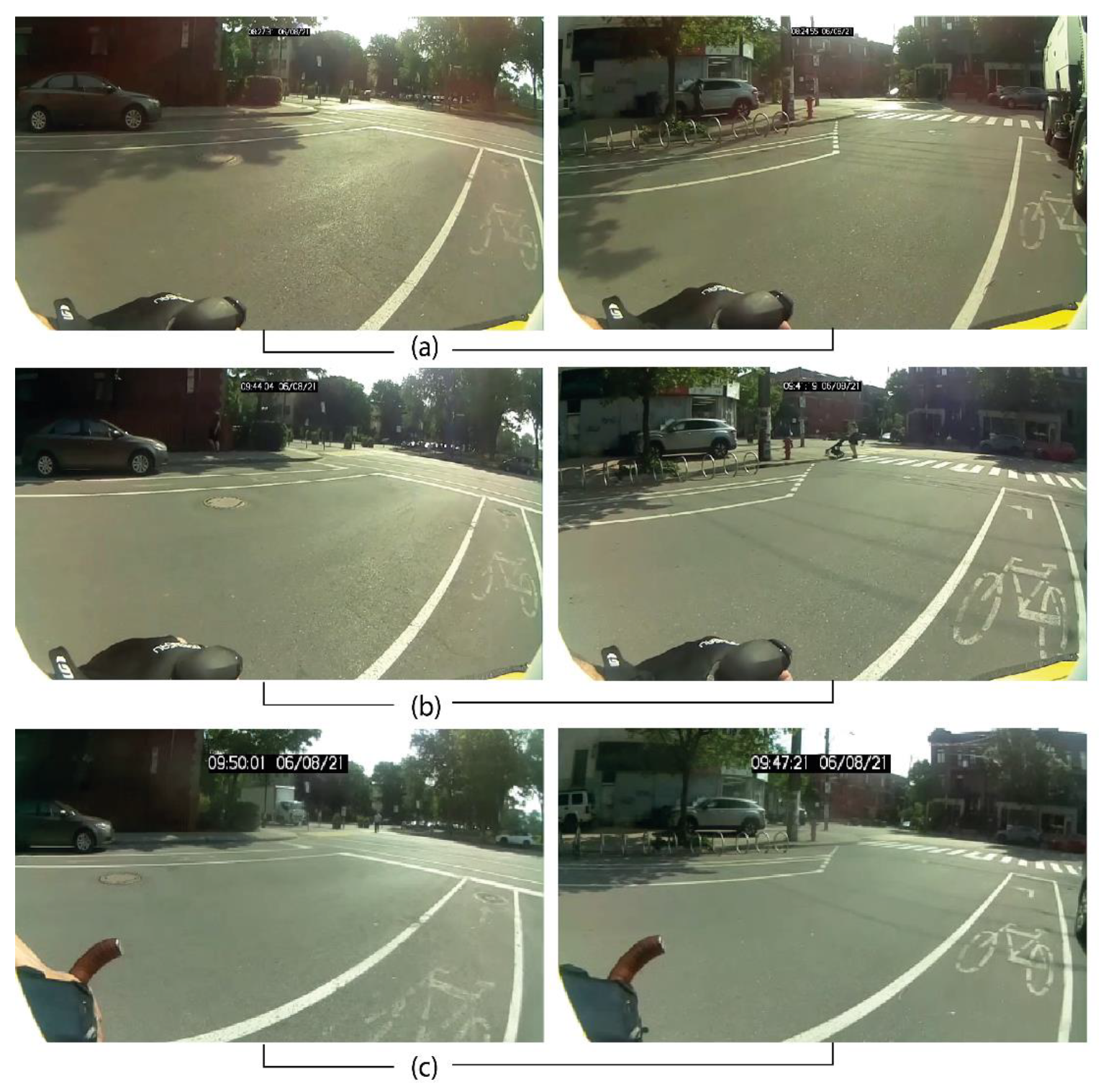
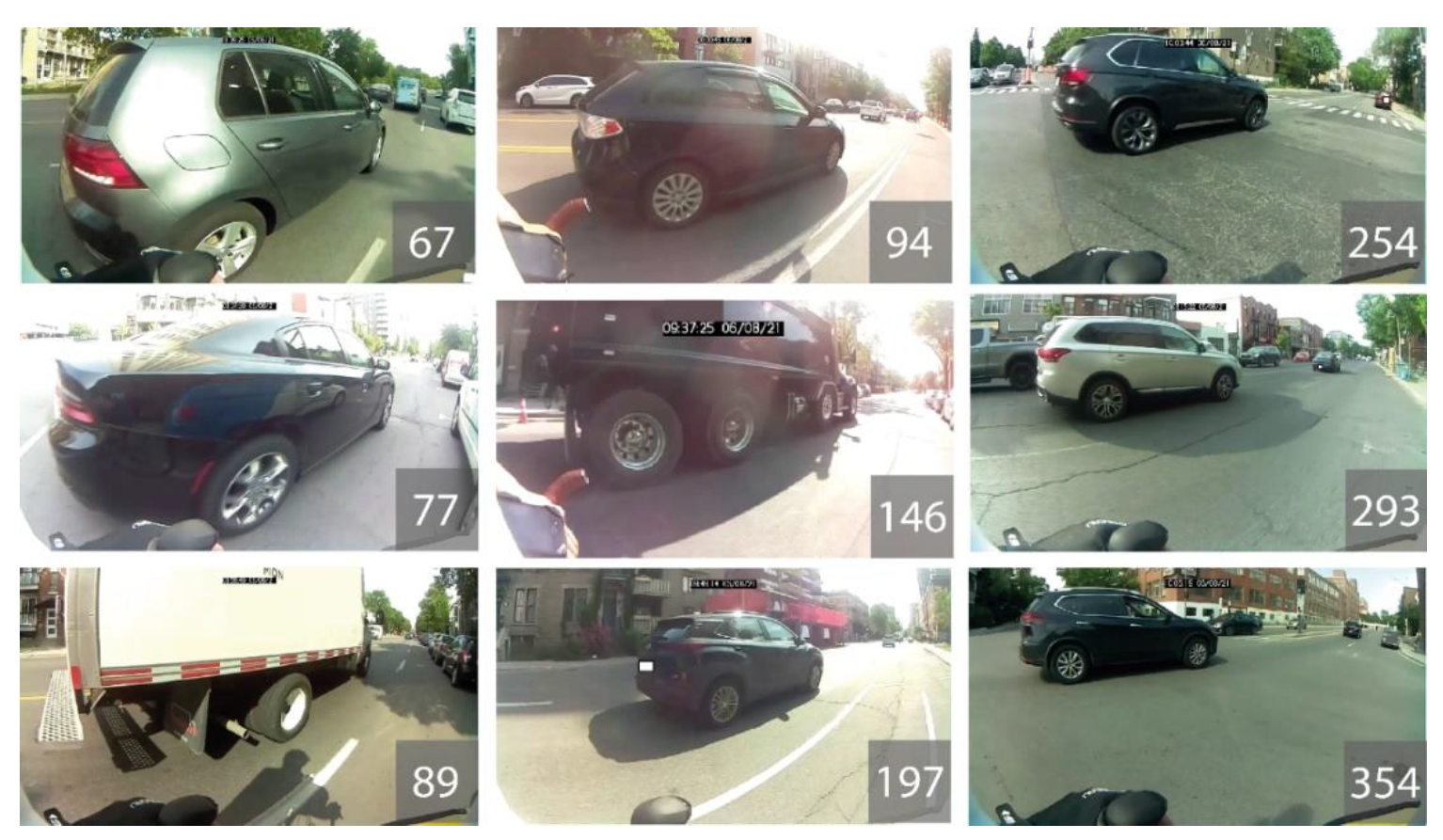
| Distance Sensor | GPS | Camera | Product | Product | |||||
|---|---|---|---|---|---|---|---|---|---|
| Study (Year) | Product | Hz | Range Distance (m) | Product | Hz | Product | Resolution(px) | Additional Device | Type and Cost ($US) of the Final Product |
| Parkin et al. (2010) [32] | NA | NA | NA | NA | NA | Helmet Camcorder Generation 5 (Archos, Igny, France) | 640 × 480 | Archos 605 MP4 recording device (Archos, Igny, France) | Multiple existing devices. 600 $US |
| Stewart et McHale (2014) [40] | NA | NA | NA | NA | NA | AT1 and ATC5K Waterproof Action Camera (Oregon Scientific, Portland, OR, USA) | 640 × 480 | NA | Multiple existing devices. 150 $US |
| Shackel et al. (2014) [29] | M-300/95 Sensor (Massa, Hingham, MA, USA) | 95,000 | 0.3–4 | NA | NA | Viosport POV 1.5 camera × 2 (V.I.O, New Hope, PA, USA) | 720 × 480 (30 fps) | Laser pointer for distance from the kerb | Multiple existing devices.Price: NA |
| Chuang et al. (2013) [28] | MB1200 XL-MaxSonar-EZ0 × 2 (Maxbotix Inc., Brainerd, MN, USA) | 60–70 | 0–6.5 | GPS (Canmore Electronics Co Ltd. Jhubei, Hsin Chu, Taiwan) | 1 | Car camera DVR black box × 5 (DOD Tech Co Ltd., Taoyuan, Taiwan) | 860 × 640 (30 fps) | Multi-function logger PhidgetSpatial Precision 3/3/3 (Phidgets Inc., Calgary, AB, Canada) | Multiple existing devices. 1290 $US |
| Dozza et al. (2016) [31] | LIDAR system UXM-30LXH-EWA (Hokuyo, Osaka, Japan) | 20 | ND | ND | 1 | ND | 1920 × 1080 (30 fps) | NA | Multiple existing devices. 5980 $US |
| Llorca et al. (2017) [33] | TruSense S200 Laser Sensor × 2 (Laser Technology Inc., Centennial, CO, USA) | 55,000 | 0.5–750 | Video VBOX waterproof 10 HZ gps data logger (Racelogic, Buckingham, UK) | 10 | Video VBOX waterproof 10 HZ gps data logger (Racelogic, Buckingham, UK) with 3 cameras | ND | TrueSense T100 (Laser Technology Inc., Centennial, CO, USA) for measure the speed of overtaking vehicles. | Multiple existing devices. 3695 $US |
| Walker et al. (2014) [30] | MB1200 XL-MaxSonar-EZ0 (Maxbotix Inc., Brainerd, MN, USA) | 10 | ND | NA | NA | NA | NA | Arduino Uno (Arduino, Scarmagno, Italy) | Custom-made. 120 $US |
| Mehta et al. (2015) [34] | ND | 10 | 0.3–4.8 | ND | ND | Camera lateral (type not defined) | ND | NA | Custom-made. Price: NA |
| Beck et al. (2019) [27] | MB1230 XL-MaxSonar-EZ3 (Maxbotix Inc., Brainerd, MN, USA) | 10 | 0–3.3 | Adafruit Ultimate GPS FeatherWing (Adafruit Industries, New York, NY, USA) | 1 | GoPro Hero 5 Session (GoPro, CA, USA) in the handlebar | ND | NA | Custom-made. Price: 693 $US |
| Device | Model | Manufacturer | Specifications | Quantity | Price (US) |
|---|---|---|---|---|---|
| Screen touch | NX3224T024 | Nextion (Shenzhen, Hong Kong, China) | Resolution: 320 × 240 px | 1 | 30 |
| Color: 65,536 colors | |||||
| Voltage: 5 V | |||||
| Distance sensor | Tfmini plus micro lidar | Benewake (Beijing, China) | Range: 0.1–12 m | 1 | 60 |
| Frequency: 100 Hz | |||||
| Resolution: 1 cm | |||||
| Accuracy: ±5 cm (0.1–5 m); ±1% (5–12 m) | |||||
| Voltage: 5 V | |||||
| GPS | BN-220 | Beitian (Shenzhen, Hong Kong, China) | Frequency: 1 Hz | 1 | 16 |
| Accuracy: 2 m in horizontal position | |||||
| Voltage: 5 V | |||||
| Small single board computer | Raspberry Pi Zero W | Raspberry Pi Foundation (Cambridge, UK) | Memory: 512 MB RAM | 1 | 30 |
| Connectivity: Bluetooth and Wifi | |||||
| Processor: 1 GHz single-core CPU | |||||
| Voltage: 3.3 V | |||||
| Hub usb | Hub zero w-BH10128PSU | Makerspot | Socket type: 4 port USB | 1 | 17 |
| Camera | RPi Camera G | Waveshare (Shenzhen, Hong Kong, China) | Field of view: 160 degrees | 1 | 25 |
| Sensor resolution: Max 1080 p | |||||
| Aperture (F): 2.35 | |||||
| Voltage: 3.3 V | |||||
| Battery Charger | HW-775 | Makerfocus (China) | Charging current: 0–2.1 A | 1 | 15 |
| Discharge current: 0–2.4 A | |||||
| Input voltage: 5 V | |||||
| Output voltage: 3.7–5 V | |||||
| Waterproof Cable micro-USB | Micro USB mount extension | Cerrxian (China) | Connector: Micro USB male/female | 1 | 15 |
| SD Card | EVO Select micro SDXC 64 Gb | Samsung (Seoul, South Korea) | Capacity: 64 GB | 1 | 15 |
| Clock | DS3231 Real time clock | Daoki (China) | Voltage: 3.3 V or 5 V | 1 | 4 |
| time accuracy: ±0.4 s/day | |||||
| Waterproof switch | Round Rocker Switch Blue | Twidec (Suzhou, China) | Voltage: 12 V | 1 | 3 |
| Current: 20 A | |||||
| Battery | 3.7 V Li-ion 18650 | Pkcell (Shenzhen, Hong Kong, China) | Voltage: 3.7 V | 4 | 22 |
| Nominal Capacity: 2200 mAh | |||||
| Usb to ttl connector | CP 2102 | Izokee (China) | Output Voltage: 3.3 or 5 V | 2 | 20 |
| Communication protocol: UART | |||||
| Usb to ttl connector | RS232 | Robojax (China) | Output Voltage: 3.3 or 5 V | 1 | 10 |
| Communication protocol: UART | |||||
| Total: | 292 | ||||
| Element | Size (High, Width and Depth in mm) | Time of Printing | Material Quantity (g) |
|---|---|---|---|
| Top cover | 105 × 120 × 34 | 15 h 40 min | 128 |
| Bottom case | 113 × 122 × 62 | 28 h 43 min | 213 |
| Raspberry pi support | 92 × 6 × 32 | 6 h 23 min | 39 |
| Distance sensor support | 35 × 14 × 26.5 | ||
| Camera support | 38 × 17.5 × 25 | ||
| Touch screen support | 80 × 61 × 6 | ||
| Charger support | 24 × 17 × 3 |
| File | Distance File | GPS File | Video File | |||
|---|---|---|---|---|---|---|
| Size (KB) | Size (KB) | Resolution (px) | Size H264 (KB) | Size MP4 (KB) | Duration (mm:ss) | |
| ID1_C1_2021_06_08_08_14_39 | 841 | 156 | 960 × 540 | 4,027,668 | 4,028,034 | 52:36 |
| ID1_C1_2021_06_08_09_29_01 | 633 | 154 | 720 × 405 | 3,226,752 | 3,227,105 | 52:06 |
| ID2_C2_2021_06_08_08_19_49 | 1081 | 169 | 960 × 540 | 3,789,376 | 3,789,765 | 56:48 |
| ID2_C2_2021_06_08_09_33_16 | 794 | 169 | 480 × 270 | 985,284 | 985,639 | 57:00 |
| Charge | Distance Sensor | ||
|---|---|---|---|
| Charging voltage | 5 V | Range (adjustable) | 2 cm–400 cm |
| Charging current | 2 A | Capture frequency (adjustable) | 30–40 Hz |
| Battery | GPS | ||
| Capacity | 8800 mAh | Horizontal resolution | 2 m |
| Technology | Li-ion | Capture frequency (adjustable) | 1 Hz |
| Operation voltage | 3.7 V | Global system | |
| Operation current | 1 A | Maximum operation time | 7 h of continuous recording |
| Camera | Operating System | Raspberry Pi OS (32 bit) | |
| Angle | 160 degrees | Wifi | 802.11 b/g/n |
| Resolution, by default Large (adjustable) | - Low (426 × 240 px) - Medium (768 × 432 px) - Large (960 × 540 px) | Bluetooth | v4.1 BLE standard |
| Aperture (F) | 2.35 | CPU | 1 GHz single-core |
| Format | h.264 and mp4 | RAM | 512 MB |
| Framerate (adjustable) | 25 fps | Spirit Level | Integrated |
| Distance Sensor | GPS | Camera | Technology | |||||
|---|---|---|---|---|---|---|---|---|
| Study (Year) | Feature | Hz | Range Distance (m) | Feature | Hz | Feature | Resolution | |
| Walker et al. (2014) [30] | √ | 10 | ND | x | NA | x | NA | Custom made: Grey plastic box and commercial devices |
| Mehta et al. (2015) [34] | √ | 10 | 0.3–4.8 | √ | ND | √ (not integrated) | ND | Custom made: Grey plastic box and commercial devices |
| Beck et al. (2019) [27] | √ | 10 | 0.3–3.3 | √ | 1 | √ (not integrated) | 3840 × 2160 | Custom made: 3D printing and commercial devices |
| Codaxus C3FT v3 | √ | 10 | 0–2.5 | x | NA | x | NA | Standard product. |
| 1m+ sensor | √ | 60 | 0.1–12 | √ | 1 | √ | Max 1920 × 1080 | Custom made: 3D printing and commercial devices |
Publisher’s Note: MDPI stays neutral with regard to jurisdictional claims in published maps and institutional affiliations. |
© 2021 by the authors. Licensee MDPI, Basel, Switzerland. This article is an open access article distributed under the terms and conditions of the Creative Commons Attribution (CC BY) license (https://creativecommons.org/licenses/by/4.0/).
Share and Cite
Henao, A.; Apparicio, P.; Maignan, D. One Metre Plus (1M+): A Multifunctional Open-Source Sensor for Bicycles Based on Raspberry Pi. Sensors 2021, 21, 5812. https://doi.org/10.3390/s21175812
Henao A, Apparicio P, Maignan D. One Metre Plus (1M+): A Multifunctional Open-Source Sensor for Bicycles Based on Raspberry Pi. Sensors. 2021; 21(17):5812. https://doi.org/10.3390/s21175812
Chicago/Turabian StyleHenao, Andres, Philippe Apparicio, and David Maignan. 2021. "One Metre Plus (1M+): A Multifunctional Open-Source Sensor for Bicycles Based on Raspberry Pi" Sensors 21, no. 17: 5812. https://doi.org/10.3390/s21175812
APA StyleHenao, A., Apparicio, P., & Maignan, D. (2021). One Metre Plus (1M+): A Multifunctional Open-Source Sensor for Bicycles Based on Raspberry Pi. Sensors, 21(17), 5812. https://doi.org/10.3390/s21175812







